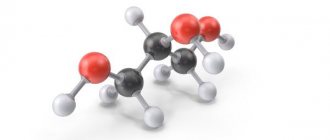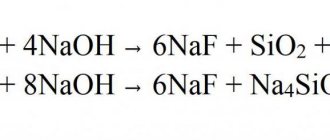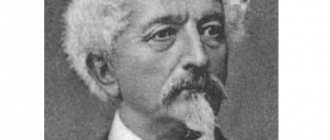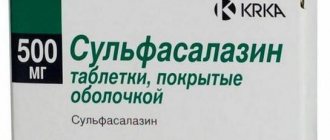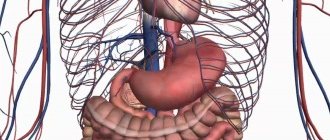Pharmacodynamics and pharmacokinetics
Sucralfate, under the influence of acids in the stomach (if the pH value is below 4), breaks down into sucrose sulfate and aluminum . Aluminum denatures mucus proteins so that sucrose sulfate can combine with them and fixate on dead ulcer tissue. Thus, a protective film is formed on the surface of the stomach, which acts as a barrier against the enzyme pepsin, bile and hydrochloric acid . The product adsorbs bile and has an anti-inflammatory effect.
The gel lines the entire surface of the affected tissues in the duodenum and stomach. The effect of the drug lasts about 6 hours. The medicine does not interact with the normal gastric mucosa.
The biological availability of the substance is low. of sucrose sulfate and less than one hundredth of a percent of aluminum are absorbed in the gastrointestinal tract . The drug is excreted mainly in feces, and a small amount through the kidneys.
Storage
The medicine must be kept in a room where the temperature ranges from 15 to 25 degrees. In addition, the place should be dry and also dark. Under no circumstances should small children be allowed near the medicine.
If all recommendations are strictly followed, the medicine can be used for no more than three years. An expired product is not allowed for further use, because At best, such a medicine will have no effect, and at worst, it will only make things worse.
Indications for use
Application of Sucralfate:
- for heartburn , medicinal ulcers ;
- with exacerbation of stomach and duodenal ulcers ;
- for the treatment of stress ulcers in the gastrointestinal tract;
- with the development of erosive and ulcerative lesions in the gastrointestinal tract associated with the use of non-steroidal anti-inflammatory drugs ;
- for reflux esophagitis, reflux gastritis, hyperacid gastritis, gastroduodenitis ;
- as part of the complex treatment of hyperphosphatemia , in persons suffering from uremia who periodically undergo hemodialysis .
Analogs
Analogues of this medicine are such drugs as: Ancrusan, Ventrisol, Flax Seeds, Alsukrsal, De-Nol, Ventr, Venter, Novobismol, Sukrat, Vis-Nol, Ulgastran, Sucrafil, Vikalin, Gastro-Norm, Ampilop, Gaviscon, Gastrotilin, Omez D, Domstal, Caleflon, Ribiril, Maalox, Alyugastrin, Gastrofarm, Dalargin, Bismofalk, Kalmagin, Vicair, Gastrotsepin, Alyugastrin, Liquiriton, Anacid, Rutacid.
Important! Only a specialist should select these or other drugs.
- If you have any symptoms of the disease, you should immediately consult a doctor. You can view a list of gastroenterology clinics on our website
- You will be interested! The article describes symptoms that make it possible to suspect the presence of liver disease in the early stages
- You will also be interested in learning more about the treatment of various diseases of the gastrointestinal tract https://gastrocure.net/bolezni.html
Side effects
Sucralfate may cause:
- indigestion , diarrhea or constipation, increased gas production ;
- headache, epigastric , back pain;
- drowsiness;
- nausea, dizziness;
- dryness of the oral mucosa;
- allergic rashes, itching , urticaria .
Of these effects, constipation .
Sucralfate, instructions for use (Method and dosage)
The dosage and duration of treatment depends on the disease and the dynamics of the disease.
Adult patients are usually prescribed 0.5 to 1 gram of Sucralfate per day, in 4 doses.
You can also take 1 gram in the morning and 1 more in the evening.
There is a treatment regimen in which they drink 2 grams of the drug, 2 times a day, 60 minutes before the first meal and at night.
The maximum amount of active ingredient that can be taken per day is 12 grams.
The average course of treatment lasts about 4-6 weeks, with a maximum of 3 months.
For children, the average daily dosage is 2 grams, divided into 4 doses.
On the recommendation of a doctor, the daily dosage can be reduced. For example, with hyperphosphatemia , if the concentration of phosphates in the plasma is reduced.
Sucralfate suspension
Release form: suspension (packages) 10 ml
Pharmacological group - gastroprotective agent
pharmachologic effect
- antiulcer
- increasing prostaglandin synthesis
- reducing pepsin activity
- forming a protective film
Ingredients - sucralfate
Indications
- Gastritis and duodenitis
- Gastritis, unspecified
- Gastroesophageal reflux
- Gastroesophageal reflux with esophagitis
- Gastrojejunal ulcer
- Gastroduodenitis, unspecified
- Alcoholic gastritis
- Acute hemorrhagic gastritis
- Peptic ulcer of unspecified localization
- Chronic gastritis, unspecified
- Chronic atrophic gastritis
- Chronic superficial gastritis
- Esophagitis
- Other gastritis
- Other diseases of the esophagus
- Other acute gastritis
- Esophageal ulcer
- Duodenal ulcer
- Stomach ulcer
Composition by components
- sucralfate
Pharmacodynamics
It has gastroprotective, antiulcer effects, forming a protective film, increasing the synthesis of prostaglandins, reducing the activity of pepsin. It has a local effect on ulcerative lesions of the mucous membrane of the stomach and duodenum. Dissolves in an acidic environment, most of the drug forms an adhesive polymer paste with basic properties. Being in the stomach and duodenum, it is transformed into a polyanion with many free negative charges, which form strong bonds with positive radicals of mucosal proteins. Thus, it forms a strong barrier that, over a long period, protects the affected areas of the mucous membrane from the influence of aggressive factors (acid, bile and pepsin do not come into contact with the ulcerated surface). It has a cytoprotective effect, promoting the synthesis of prostaglandins in the mucous membrane. The drug moderately inhibits the activity of pepsin.
Pharmacokinetics
It is poorly absorbed from the gastrointestinal tract and therefore does not have a significant systemic effect. The drug is absorbed by 3-5% of the administered dose, more than 90% is excreted unchanged in the feces.
Application
Peptic ulcer of the stomach and duodenum in the acute phase; reflux esophagitis gastritis, gastroduodenitis, heartburn, drug ulcer.
Dosage regimen
Prescribe 1 g 4 times a day (1 hour before meals and before bedtime). It is also possible to take it twice a day: 2 tablets or 2 bags of granules in the morning and evening. The maximum daily dose is 8 g. The tablet can be swallowed whole with a small amount of liquid, or, like granules, mixed in 0.5 glasses of water and drunk. The average duration of treatment for peptic ulcer is 4-6 weeks. If necessary, treatment is continued for up to 12 weeks.
Side effects
When used according to indications and in the recommended dosage, patients usually tolerate the drug well. In rare cases - dyspeptic disorders (constipation, diarrhea, nausea, dry mouth), itching, pain in the lumbar region, insomnia, dizziness. In patients with renal failure, serum aluminum and phosphate concentrations should be monitored.
Contraindications
Pregnancy, children (up to 4 years), severe renal dysfunction, bleeding from the gastrointestinal tract (GIT), hypersensitivity.
Interaction
If it is necessary to prescribe antacids simultaneously, they should be taken 30 minutes before or 30 minutes after taking sucralfate. In case of insufficiency of renal function, monitoring of the concentration of aluminum and phosphates in the blood serum is necessary. Sucralfate reduces the absorption of tetracyclines, cimetidine, ciprofloxacin, norfloxacin, ranitidine, digoxin, warfarin and theophylline. Therefore, the interval between taking sucralfate and the above drugs should be at least 2 hours.
special instructions
There are no known harmful effects of the drug on the fetus or child. However, for pregnant women and breastfeeding women, treatment is recommended only in urgent cases.
Interaction
The drug reduces the effectiveness of levothyroxine, tetracycline, sulpiride, phenytoin.
The drug is not recommended to be combined with digoxin ; this may lead to a decrease in the effectiveness of both drugs.
When taken simultaneously, the absorption capacity of amitriptyline and its effectiveness decreases.
Combining the drug with indirect anticoagulants may lead to a decrease in the effectiveness of anticoagulants ( Warfarin ).
It is assumed that the combination of Sucralfate with amphotericin B, tobramycin, colistin sulfate may lead to the formation of chelate complexes and a decrease in the effectiveness of both drugs.
The medicine reduces the effectiveness of antimicrobial agents - fluoroquinolones .
When taken simultaneously with ketoconazole and fluconazole , the drugs are less absorbed.
The combination of a substance with theophylline leads to a change in the pharmacokinetics of the latter. It is also assumed that the absorption of theophylline from lek is significantly reduced. time-release forms.
of quinidine when combined with this substance has been reported The drug should be combined with caution with roxatidine, cimetidine and ranitidine .
If there is a need to take medication and antacids , then this should be done with an interval of 30 minutes.
It is not recommended to combine the drug with other products containing aluminum .
Price
Important! For more information, please contact your nearest pharmacy. The article presents average prices across the country.
The cost of a medicine is based on a number of factors, which include the individual markup on the product made by each pharmacy, the purchase price, and the costs incurred by the company for transporting the product. Depending on the country, the price will vary significantly. This is due to the fact that countries have their own currencies, which have exchange rates.
Russia
In Russia, you will have to pay an average of 295 rubles for this medicine.
Ukraine
In Ukraine, you need to pay 145.89 hryvnia for the same drug.
Video on the topic: Nutrition for gastritis
special instructions
If a patient develops convulsions and drowsiness , this may be a sign of aluminum toxicity .
phosphate during treatment .
Sucralfate is not intended for intravascular injection . This can lead to cerebral or pulmonary .
If the patient has a predisposition to the formation of bezoars , then the drug increases the likelihood of their occurrence.
Special information
This section provides information for a special category of citizens.
Impact on the driver
This drug may not have the most favorable effect on the driver. As a result of taking the pill, a person may experience severe stomach or heart pain. This is important for drivers to take into account.
Pregnancy
Use with caution during pregnancy and breastfeeding. Pregnancy is a very exciting and at the same time important time in the life of any girl. That is why, with the onset of this time, many of them try to limit themselves in taking pills. How are things going with this medicine? During pregnancy, it is strictly forbidden to take the drug Sucralfate. This measure is due to the fact that the active substance can have a negative effect on the girl’s fetus.
It is also highly undesirable to take this medication while breastfeeding.
Adolescence and infancy
This drug should not be given to children under one year of age.
Sick kidneys
If you have kidney disease, you should stop taking this medicine.
Sick liver
If a person has a diseased liver, then a dose adjustment is required.
Acceptance of funds by senior citizens
At this age, dosage adjustment may be required.
Dispensing medicine from pharmacies
On prescription.
Drugs containing (Sucralfate analogues)
Level 4 ATC code matches:
Ventrisol
Novobismol
Vis-Nol
De-Nol
Gastrocepin
Dalargin
Venter
Vikair
Omez DSR
Omez D
Gastrofarm
Gaviscon
Vikalin
Medicines that contain Sucralfate: Venter, Alsukral, Sucralfate, Ancrusal, Sukrat, Ulgastran .
Reviews of Sucralfate
Some reviews about the drug:
- “... My husband is a driver. Due to the nature of his profession, he has frequent stomach pains. The doctor advised me to take Venter. It's inexpensive and helps a lot. My husband says my stomach hurts less and less often”;
- “... An excellent remedy for those who have stomach ulcers, and also very economical. During exacerbations, after taking a few tablets, I already feel better”;
- “...I have gastritis. I tried a lot of medications, expensive and cheap. During an exacerbation of the disease, I immediately start taking these pills, relief occurs almost immediately. The only side effects are constipation, and even that is rare.”
Reviews
Patients, as a rule, leave positive opinions about this medicine. Among the obvious advantages, people note the low cost, a large list of analogues, the ability to take the product during pregnancy/breastfeeding, and a convenient release form.
Among the disadvantages, patients note that pharmacies, as a rule, do not have this drug. As a result, people are forced to wait until the drug is delivered or buy another analogue.
In addition, some people are afraid of the presence of side effects and contraindications, which is the basis for refusing to take the drug.
